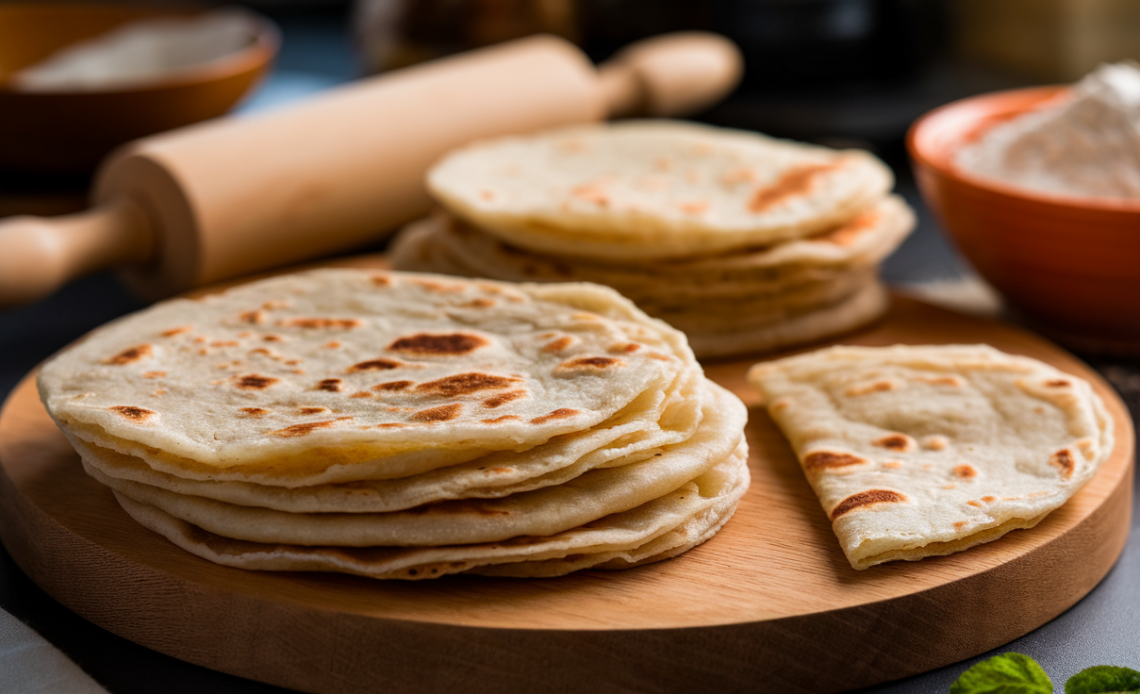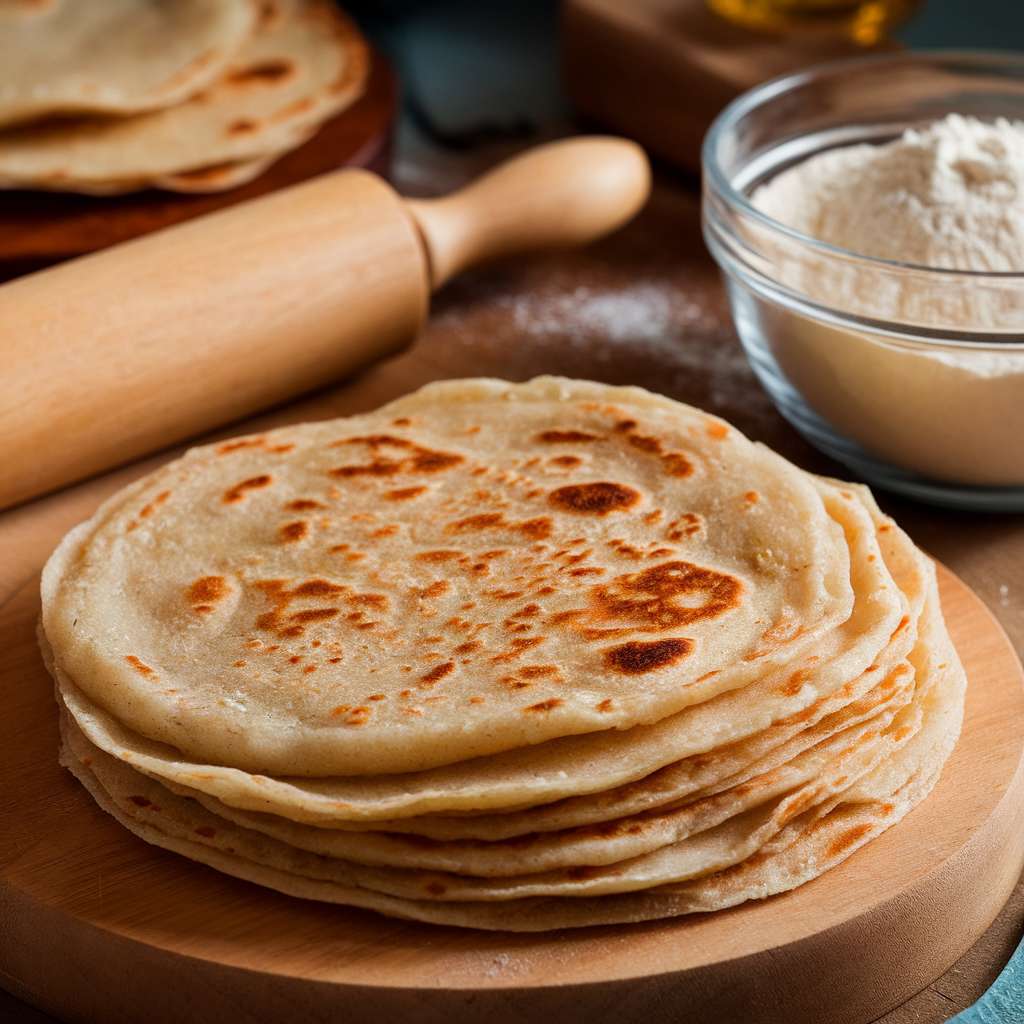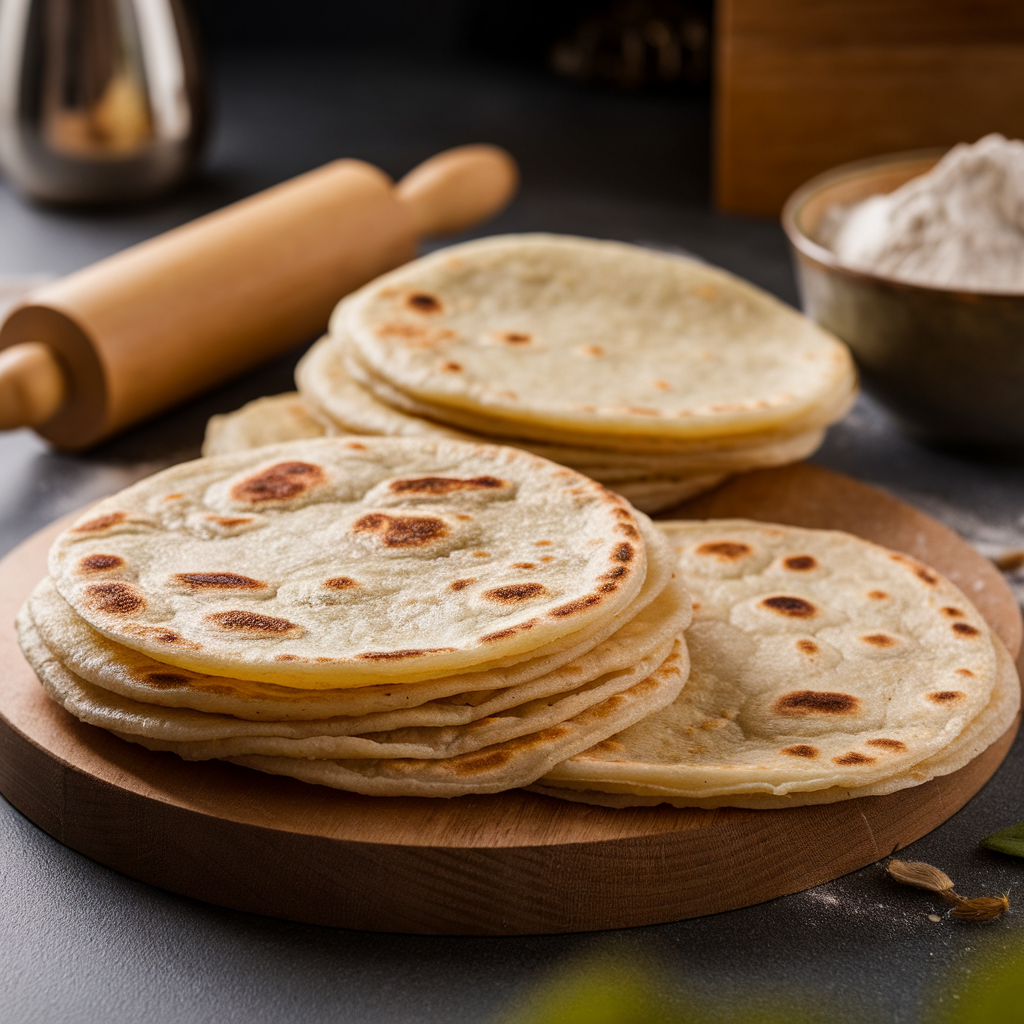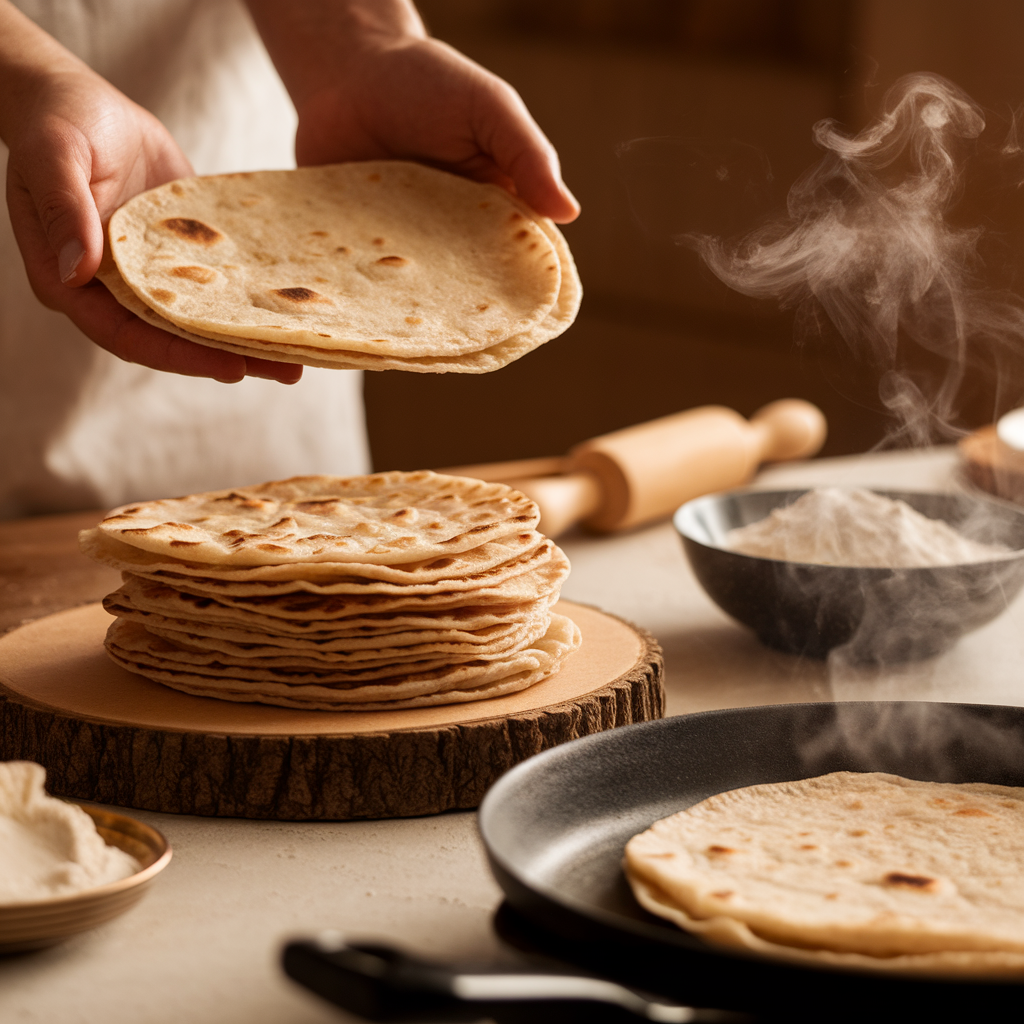
Introduction: The Magic of Soft Chapati
When it comes to simple, wholesome, and satisfying food, few things compare to a perfectly made chapati — a warm, tender, and soft Indian flatbread. Also known as roti, chapati has fed millions across generations, not only in India but across South Asia, the Caribbean, and Africa.
This chapati recipe is more than just instructions. It’s a celebration of food heritage — a culinary bridge between generations and cultures. If you’re seeking an easy and authentic homemade chapati guide, you’re in the right place. We’ll take you through ingredients, techniques, cultural tips, serving suggestions, and even troubleshooting, ensuring your chapatis are soft, puffed, and perfect every single time.
Whether you’re cooking Indian meals, exploring Trini food, or simply looking to diversify your Indian bread recipes, this comprehensive recipe guide is tailored just for you.
What is Chapati?
Chapati (चपाती), derived from the Hindi word chapat (meaning “flat”), is an unleavened flatbread made from atta flour — a soft whole wheat flour. Unlike naan, which is leavened with yeast or baking powder and often baked in a tandoor, chapati is cooked dry on a hot skillet or tava.
This beloved Indian flat bread is a daily essential in countless homes. With roots in Indian tradition and cultural adaptations across the globe, the chapati holds a special place as both a staple and a symbol of nourishment.
From a Trinidadian roti served with curried chickpeas, to Kenyan chapatis enriched with oil, each regional variation adds to the story of this iconic bread.
Why Make Homemade Chapati?
If you’ve only ever had store-bought or frozen roti, you’re in for a delicious surprise. Homemade chapati is:
- Soft and tender — with just the right chew
- Vegan and healthy — made with whole wheat, no additives
- Budget-friendly — only 2-3 pantry ingredients
- Customizable — stuff it, brush it, spice it, or fold it
- Quick to make — 30 minutes start to finish with practice
Let’s dive into the details of how to make the softest, fluffiest roti at home — better than any packaged brand!
Ingredients for the Perfect Chapati Recipe
Making soft bread like chapati requires only a handful of basic ingredients:
🌾 Base Ingredients:
- 2 cups atta flour (whole wheat flour) – Preferably Indian-style for best texture
- ¾ cup warm water – Adjust as needed during kneading
- 1 tsp salt (optional) – Enhances flavor
- 1–2 tsp oil or ghee (optional) – Improves softness and elasticity
🧂 Additional:
- Extra flour for dusting – During rolling
- Ghee or melted butter – For brushing after cooking (optional)
📝 Tip: Atta flour is softer and finer than typical Western whole wheat flour. It makes a big difference. Look for brands like Aashirvaad or Pillsbury Atta at Indian grocery stores.

Step-by-Step Instructions: How to Make Soft Chapati
Mastering the roti recipe is about process, not perfection. Here’s how to do it right:
1. Mix the Dough
In a large mixing bowl:
- Add 2 cups of atta flour and salt, if using.
- Gradually pour in ¾ cup warm water, mixing with your fingers or a wooden spoon.
- Add 1 tsp of oil while mixing for extra pliability.
- Combine until you form a shaggy dough.
2. Knead the Dough Thoroughly
Transfer the dough onto a clean counter:
- Knead it for 8–10 minutes, using the palm of your hand to push, fold, and turn the dough.
- Add a sprinkle of flour if too sticky or a drizzle of water if too dry.
- After kneading, the dough should be soft, elastic, and smooth, not crumbly or sticky.
🔥 Kneading activates gluten and builds structure — essential for puffing.
3. Let the Dough Rest
This step is crucial for making soft chapatis:
- Cover the dough with a damp cloth or lid.
- Let it rest for 30 minutes to 2 hours.
🧘 Why rest? Resting relaxes the gluten strands, making the dough easier to roll and preventing shrinkage during cooking.
4. Divide and Roll the Dough
Once rested:
- Divide the dough into 10 even portions and roll each into a ball.
- Lightly flour your surface and rolling pin.
- Flatten a ball into a small disc, then roll it into a thin, even circle about 6 inches wide.
⚖️ Keep pressure even while rolling to avoid thick edges.
5. Cook the Chapati on a Hot Tava
Preheat a heavy skillet or tava over medium-high heat:
- Place the rolled chapati onto the hot surface.
- Cook until you see bubbles (about 30 seconds).
- Flip and cook the other side (30–40 seconds), pressing gently with a spatula.
- Flip again — now it should puff as steam forms inside.
🍳 If it doesn’t puff fully, don’t worry — it’ll still be delicious. Softness comes from the dough and cooking heat.

6. Keep Warm and Serve
Once cooked:
- Transfer chapatis to a cloth-lined bowl or plate.
- Stack and cover with a clean towel to trap steam and keep them soft.
- Optionally, brush with melted ghee or butter for flavor and sheen.
Repeat with remaining dough.
Texture Test: How to Know You’ve Nailed It
Your chapati should be:
✅ Light brown with darker spots
✅ Soft and pliable, not stiff
✅ Easy to fold without cracking
✅ Slightly puffed (not flat like a tortilla)
Troubleshooting: Common Mistakes and Fixes
Even seasoned cooks run into issues. Here’s how to solve them:
| Problem | Reason | Fix |
|---|---|---|
| Chapati is hard | Dough is too dry, not rested | Add more water; rest longer |
| Doesn’t puff | Uneven rolling or low heat | Roll evenly; increase heat |
| Cracks while rolling | Dough is under-kneaded or dry | Knead more; cover with damp cloth |
| Sticks to pan | Pan not hot enough or too much flour | Use medium-high heat; shake off excess flour |
| Turns stiff after cooking | Overcooked or not covered immediately | Shorten cook time; stack under cloth |
Cultural Roots: Chapati Around the World
Chapati isn’t just Indian bread — it’s a symbol of shared cultures:
🇮🇳 India:
- Daily staple in north and central Indian homes
- Served with lentils, curries, chutneys, pickles
🇹🇹 Trinidad & Caribbean:
- Known as Trinidadian roti or buss-up-shut
- Thinner, larger, often filled with curry or channa
🇰🇪 East Africa:
- Chapati is rich, layered, sometimes sweet
- Made with oil and rolled like paratha
🌎 Global:
- Found in UK, USA, Canada through diaspora
- A bridge for second-gen cooks to explore heritage

Variations on Traditional Chapati Recipes
1. Stuffed Roti
Fill with mashed spiced potatoes, lentils, or paneer before rolling and cooking.
2. Masala Chapati
Add turmeric, chili powder, or cumin seeds to the dough for flavor and color.
3. Ghee Layered Chapati
Brush layers with ghee during folding to mimic a flaky paratha-style bread.
4. Trini Roti Skin
Use all-purpose flour, add baking powder, and cook on an oiled skillet. Tear and fold like a soft crepe — classic Trini food style.
What to Serve With Chapati
Chapati is more than a side — it completes the meal. Try pairing with:
- 🍛 Chana Masala – Tangy chickpeas
- 🧈 Butter Chicken or Paneer – Rich and creamy sauces
- 🥬 Saag or Palak Paneer – Spinach-based comfort
- 🍲 Dal Tadka – Spiced lentils
- 🥗 Cucumber Raita or Yogurt – Cool contrast to spicy mains
- 🧄 Garlic Pickle or Mango Chutney – Tangy additions
Or use as a wrap for kebabs, tofu, falafel, or grilled veggies!
Storage, Reheating & Meal Prep
🧊 Storing Chapati:
- Store leftovers in an airtight container.
- Keeps 2 days at room temperature or 1 week in the fridge.
🔥 To Reheat:
- Microwave for 10–15 seconds, wrapped in a damp towel.
- Or reheat on skillet with a dab of ghee or water for moisture.
🍱 Freezing Tip:
- Par-cook chapatis, layer with wax paper, and freeze.
- Cook from frozen for instant soft chapati any time!
Final Thoughts: The Heart of Indian Home Cooking
Learning how to make soft chapati is a gift to yourself. This wholesome, simple bread represents more than nutrition — it’s a daily ritual of care in many households.
From the comforting smell of warm bread to the joy of scooping up a rich curry, chapati isn’t just a recipe — it’s an experience.
Whether you’re exploring Indian bread recipes, dabbling in Trini food, or reviving your family’s traditional roti recipe, this guide helps you master it with ease.






